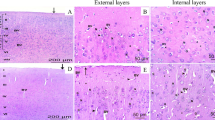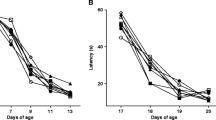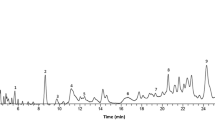Abstract
The effects of lead (Pb) and selenium (Se) interactions on central nervous system (CNS) functions were seen in adult rats by both biochemical and histologic pathological alterations. Pb administration of 20 mg/kg body wt for 8 wk showed degenerative changes only in the cerebral cortex. The changes in the cerebellar regions were not significant. Biochemically a marked decrease in the DNA, RNA, and protein content was seen following lead treatment. These decreases were significant in both the regions of the brain. During the concomitant administration of Pb and Se, the alterations in the transverse section of cerebral cortex showed only marginal changes. The values of DNA and RNA content showed significant improvement in both regions of the brain compared to the Pb treated group.
Similar content being viewed by others
References
K. Burton,Biochem. J. 62, 315–323 (1956).
G. Cerriotti,J. Biol. Chem. 214, 59 (1955).
O. J. Lowry, N. J. Roxbrough, A. L. Farr, and R. J. Randall,J. Biol. Chem. 195, 265–275 (1951).
A. Oskarsson and E. Lindy,Acta Pharmacol. Toxicol. 56, 309–315 (1985).
P. W. Lampert, F. Garro, and A. Pentschew, inSymposium on Brain Edema, Hlatzo I. and Seitalberges F. eds., Springer, NY, p. 207 (1967).
J. M. Davis and D. J. Svendsgard,Nature (Lond.) 329, 297–300 (1987).
M. R. Cullen, J. M. Robins, and B. Eskenazi,Medicine 62, 221 (1983).
V. Srivastava and M. L. Thakur, in:Nutrition and Child Health: Prospectives for the 1980’s, p. 191 (1981).
I. A. Michaelson,Toxicol. Appl. Pharmacol. 26, 539–548 (1973).
J. L. Kennedy, G. R. Grigis, G. S. Rakhra, and D. M. Nichells,J. Neuro sci. 59, 57 (1983).
J. Dobbing, Vulnerable periods in developing brain, inApplied Neurochemistry, Blackmell Scientific Publication, Oxford, pp. 287–316 (1968).
H. E. Ganther, C. Goudie, M. L. Sunde, and M. J. Kopecky,Science 175, 1122–1124 (1972a).
D. V. Frost,Applied Neurochemistry, vol. 4, D. D. Hemphill, ed., University of Missouri Press, Columbia, p. 259 (1993).
Author information
Authors and Affiliations
Rights and permissions
About this article
Cite this article
Nehru, B., Dua, R. & Iyer, A. Effect of selenium on lead-induced alterations in rat brain. Biol Trace Elem Res 57, 251–258 (1997). https://doi.org/10.1007/BF02785293
Received:
Accepted:
Issue Date:
DOI: https://doi.org/10.1007/BF02785293




